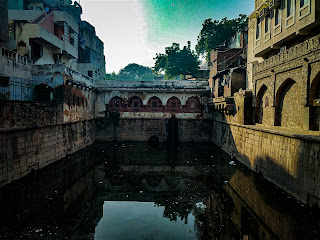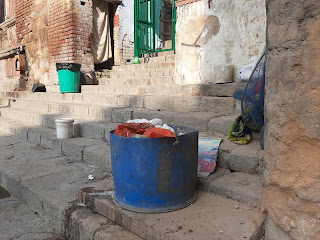The Baolis of Delhi: Nizamuddin Baoli and a Tale of Two Worlds by Simran Kaur Saini
“The scent of flowers wafted through the air, engulfing us with its charm and a promise of a mystic journey ahead. Walking through the narrow lanes, our feet were careful to dodge the muddy puddles below. A calming feeling descended upon us despite the hustle bustle around. For even with the cacophony of the shopkeepers around, the serene calm of the baoli made the site cover a delight.”
 |
| Image 1: The Nizamuddin baoli. |
If you thought that this blog will be a prashasti of the site cover undertaken, then let me warn you: Our experience, as you may have gauged from the previous baoli blogs, well, isn’t all roses and sunshine (there were a lot of roses though quite literally). However, by the time you finish reading this piece, you will understand that even in those challenges, the essence of the opening lines still persevered. So come with me on this journey which involved endless waiting and patience, and, well, lessons in how to scale walls.
It was probably after half a month that I was meeting Medha again, my partner in these lovely baoli covers without whom checking out some odd wedding photoshoots and tik tok shoots (details in the other blogs coming soon evil laughter) are almost incomplete. Pardon for I digress a lot; nevertheless, Medha and I decided to walk on foot from the metro station to the Nizamuddin Dargah where our baoli was located. The baoli in question is the Nizamuddin baoli near the northern gate of the Nizamuddin Dargah. Built in 1321- 22 CE during the reign of Ghiyas-ud- Din Tughlaq, the baoli has an interesting folklore associated with it. It is said that Ghiyas-ud- Din Tughluq had forced all the labor available to work on Tughlaqabad at the same time when the work on the baoli was going on. Forced to abandon their work on the baoli, Khwaja Nizamuddin Auliya requested the workers to work on the baoli during the night. When Ghiyas-ud- Din found out about this, he banned the sale of oil for lighting the lamps out of anger. The Khwaja cursed the city of Tughlaqabad and the lamps were lit miraculously with water. This story still finds an echo with the site and gives to the baoli its sacred, mystic character.
Going towards the baoli, roads slowly turned into narrow lanes; shopkeepers started pitching in their lockers for shoes and many offered us flowers to offer inside the shrine. After asking multiple times, the people guided us to the baoli, which was, fortunately, quite within our sight and reach. But, wait a minute. Is there any site cover which is complete without a twist? (Hint: Purana Qila)
If the hint could not help, here it is. The baoli was locked. Locked. And no, here one could not try taking pictures from other angles as there was just one single metal gate that could provide access to the baoli. We were disheartened to say the least. Trying desperately to get some glimpse of the site, we tried to push our hands through the metal bars in order to get some photos and videos. However that still wasn’t enough. So our solution to the great difficulty at hand? Make sad, puppy eyes and keep on staring at the shopkeepers nearby, silently pleading with them to open the gate somehow.
If the hint could not help, here it is. The baoli was locked. Locked. And no, here one could not try taking pictures from other angles as there was just one single metal gate that could provide access to the baoli. We were disheartened to say the least. Trying desperately to get some glimpse of the site, we tried to push our hands through the metal bars in order to get some photos and videos. However that still wasn’t enough. So our solution to the great difficulty at hand? Make sad, puppy eyes and keep on staring at the shopkeepers nearby, silently pleading with them to open the gate somehow.
And viola! It worked! Well, that included an hour of waiting around near the baoli gate, pestering the shopkeepers with questions and then making sad, disappointed faces again, but yes it worked. And so as soon as the gate opened, we went in slowly with widest grins on our faces like excited children who might have just discovered a chocolate factory. The baoli is simple in plan with a set of steps leading down into the square tank. There is no separate well; instead the tank itself functions as a well. The baoli is only accessible from the northern side; the southern portion consists of an arcaded chamber with red sandstone jalis while structures such as Chini ka Burj, tombs of Bai Kodadai, Zuhra Aga and Fatima Bibi and Lal Chaubara are located to the west and north- west of the baoli. The entrance to the Dargah is towards the eastern side. This baoli was, thus, not like the imaginary stepwells, isolated and spooky but rather gave out a very vibrant aura mixed with colours of the past and present. We, quite literally, took in every inch of the baoli accessible to us. A child, sitting on the baoli steps, offered to become our guide. A guide that even demonstrated how to scale the wall in order to access the Chini ka Burj from the baoli premises (No, we did not do that).
 |
| Image 2: The Southern façade. |
 |
| Image 3: The Western side of the baoli. |
The entrance to the baoli, along with the steps leading into the tank, was littered with trash, although someone did come to clean a bit of it. The water in the tank was also littered with banana peels and other waste, and thus made the water unfit for use. However, we did witness worshippers using the water to fill their bottles and to wash their face. This observation convinced us of the mystic power that the baoli had over the worshippers, a promise of well- being in the form of water. There were small openings in side walls from where water was flowing into the tank. The environmental damage was visible but not to a great extent. There was no information board or signage about the baoli as well. Another striking observation that we came across was that along the other historic sites, there was also large scale urban growth along the baoli walls, making the maintenance of the site a bit challenging.
 |
| Image 4: Entrance to the baoli. |
 |
| Image 5: Steps leading into the tank. |
 |
| Image 6: The water in the tank. |
The baoli, under the jurisdiction of the Dargah committee, has had its share of conservation and restoration work done over a period of time. Around 2007- 2008, when some portions of the eastern façade collapsed, a major restoration work was undertaken by the Aga Khan Trust for Culture. This restoration work, however, was no simple work of conservation and repair. Rather, the concept of urban regeneration and community development was implemented wherein preservation of the baoli was done by actively involving the community and by looking at their needs too. However, the baoli is again falling back into the danger of being lost in oblivion. While worshippers visit the baoli for its sacred value, the interview with few locals showed how many were detached from the stories that the baoli carried. The rapid use and deterioration of the water in the baoli has to be kept under check. The baoli, with its utilitarian function intact, can then continue to contribute to the needs of development and water requirement in a sustainable way. Thus, regular maintenance along with awareness about the baoli as a distinct structure in itself is imperative.
The baoli is one of the examples where a stepwell continued to feature in the memories of the people and was not really disconnected with the present reality. A stepwell, which, soaked in itself not just tales of the past, but also the experiences of the communities. The baoli, if maintained properly, can be a great example of how heritage preservation and development are not always in conflict with each other. The Nizamuddin baoli in a sense represents a tale of two worlds, that of past and present; of the sacred and urbane. And within this tale is the essence of the baoli that continues to glow away, shifting and changing in each context.
 |
| Image 7: Members Medha and Simran at the baoli. |



Baolis were not just used for people to fetch water and travellers but also had religious purposes. This blog succinctly presents the condition of the baoli and challenges that it faces. Even though it has been already been restored but the water has been littered with wrappers, banana peels, etc. There is a need to keep in check that this does not happen. A very well written blog!!!!!
ReplyDeleteMedha Sharma